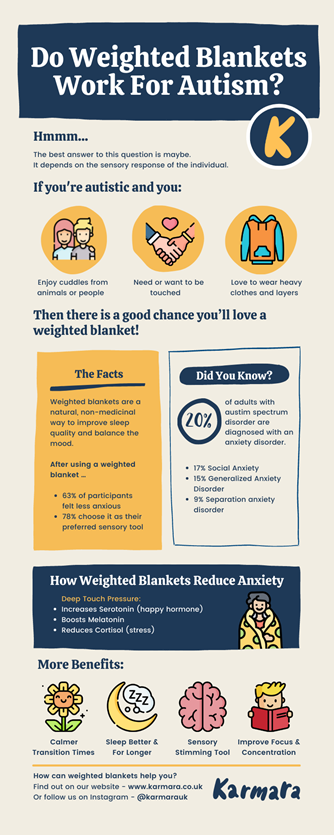This article offers information on weighted blankets and autism
Occupational therapists (OTs) have long used weighted blankets to help those with sensory issues and autism.
But these blankets aren’t just a sensory tool anymore. They’ve moved into the mainstream and have become hugely popular.
But, do weighted blankets actually do anything, or is it all just a scam?
Well, autism isn’t a set of defined symptoms that get more severe as you “move up” the spectrum.
If you’re an autistic person, you have a unique set of neurological differences.
Your needs can be recognised and accommodated in different ways.
That’s why the question “do weighted sensory blankets work?” has so many different answers.
What Exactly Is a Weighted Blanket?
A weighted blanket is a heavy therapeutic blanket designed to improve sleep, ease anxiety and treat sensory issues by distributing pressure over the body.
Weighted blankets are designed to relieve stress and create a sense of calm. They do that by distributing pressure on the body.
Weighted blankets work using deep touch pressure therapy (DTP) to regulate chemicals in the brain and rebalance the mood.
Pressure points all over the body are activated when pressure is applied to them (much like a hug or a deep tissue massage) causing a release of calming hormones.
The snug, calming sensation you feel when you are being cuddled is exactly how a weighted blanket should make you feel.
Do Weighted Blankets for Autism Actually Work?
Weighted blankets provide a deep pressure sensation all over the body, which is a form of sensory input. If you seek or enjoy heavy sensory input, a weighted blanket can feel calming and relaxing. A weighted blanket cannot work effectively for autistic people who are overwhelmed and irritated by heavy touch.
I’m not going to bore you with a million stats, so put simply:
For those who get cravings or require constant sensory input, a weighted blanket can be a very useful sensory tool. But, for someone who is easily over-stimulated by touch and pressure they are useless.
Some autistic individuals with sensory differences prefer different types of sensory input (e.g. touching soft objects or looking at lights). Others enjoy deep pressure, but prefer it from a hug or from tight clothes.
What’s the bottom line?
Understanding yours or the individual’s sensory processing needs is the first step to take before buying a weighted blanket.
Signs You’ll Love a Weighted Blanket
• You like to use multiple blankets at the same time
• You enjoy contact e.g. cuddling with a pet
• You enjoy deep touch pressure e.g. being squeezed between objects/cushions
• You like to wear heavy clothes or layers
Want to know more?
The above article is a snippet taken from an in-depth guide written by weighted blanket specialists, Karmara. Follow the link to read Karmara’s full article on Weighted Blankets for Autism where you can learn more about:
• The benefits of weighted blankets for autism
• How weighted blankets help with sensory disorders
• Signs you shouldn’t buy one
• How to buy the right weighted blanket
The Truth About Weighted Blankets for Autism
Editor’s note
Readers might also be interested in the article below on weighted blanket safety offered by Layla.




